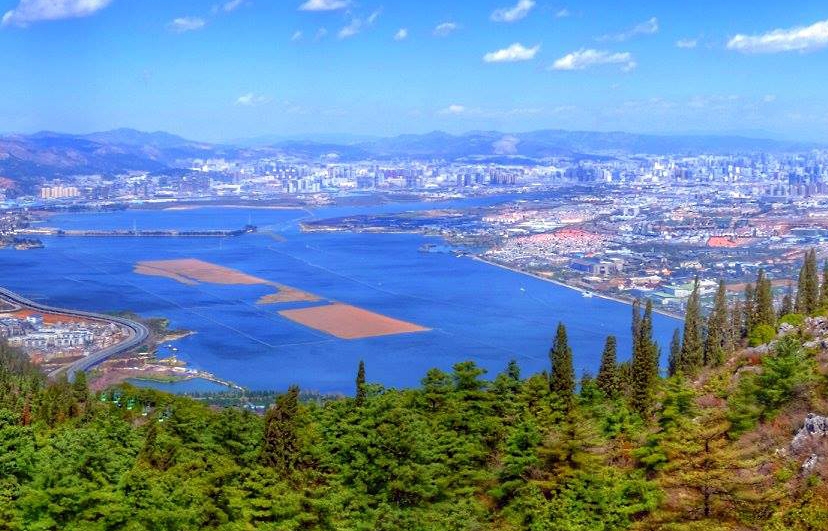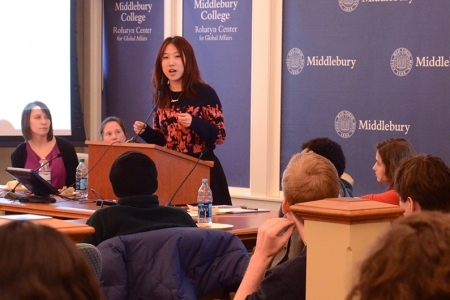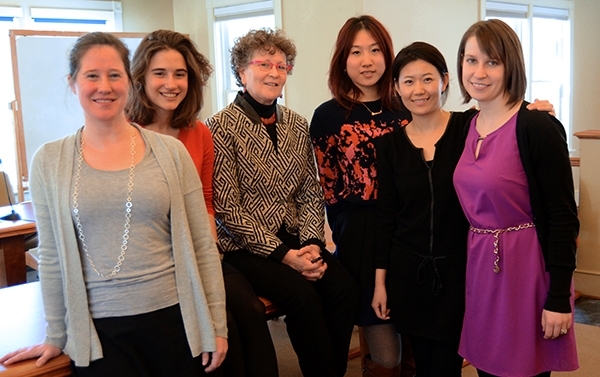What Pressures Caused the Attack in Kunming?

MIDDLEBURY, Vt. – Ethnic tension, religious differences and economic pressures may have all played a part in the March 1 rampage that left 29 dead and 143 wounded at a train station in Kunming, China.
A range of opinions emerged from a panel discussion hosted by the Rohatyn Center for Global Affairs at Middlebury College – a panel that included a student from China, an American student who studied in Kunming, and members of the Middlebury faculty.
Interest in Kunming is heightened on the Middlebury campus because the college maintains a study abroad site in the city of Kunming, the capital of Yunnan province in south central China. With a population of approximately 6.4 million people, the so-called “city of eternal spring” has played host since 2010 to 137 students enrolled in the C.V. Starr-Middlebury School in China in Kunming, including 25 undergraduates at the present time.
(All of the students enrolled in the Middlebury program in Kunming are safe and accounted for – a fact that Middlebury President Ron Liebowitz reported to the college community in an email on the day of the attack.)

The news media and sources inside China have pointed to members of the Uighur minority, a Turki-speaking population in China that most commonly adheres to Muslim practices, as the cause of the horrific attack. But the moderator of Thursday’s panel discussion, Professor Tamar Mayer, urged caution in coming to that conclusion.
Mayer, who is the director of the Rohatyn Center and a geographer who researches Uighur identity, introduced the idea that forces within China could be making scapegoats of the Uighurs.
“Terrorist organizations usually claim responsibility that they did something because they want to get the political benefits from it,” Mayer said. “There is no bad publicity for terrorists. But in the case of the Uighurs [and the recent attack in Kunming], we have not seen anybody taking responsibility. In fact we have seen condemnation.”
She continued: “There are a lot of markings in this case that it was not the Uighurs. The Uighurs do not wear black, and the pictures of the attackers showed them wearing black… There are people saying it could be the Islamic Jihad in general that may be supporting the Uighur cause, but that does not mean it’s the Uighurs who caused the attack.”
Mayer conceded the difficulty of discerning fact from fiction after an event like the Kunming rampage because the Chinese government controls the news media and has clamped down on social media. (The New York Times on March 3 reported that government censors have been deleting postings on popular sites such as Twitter and others.)

Mayer said the issue is much larger than the Uighurs’ claim to Xinjiang as their homeland “given the fact that the coal, the gold, the oil, the natural gas and all of these resources either come from or go through Xinjiang,” which is an autonomous region in northwest China where Uighurs are in the majority and Islam is the prevailing religion.
There could be other forces at play in the Kunming attack and Mayer urged the audience to be “careful of the danger of scapegoating any one group of people.”
Jessica Teets, a panelist and associate professor of political science, agreed with Mayer that the incident in Kunming may be part of larger, more complex issue with deep economic implications.
“There is not a lot of social integration between the Han majority and minority groups in China, and there’s an economic trend here where we see in places like Xinjiang and in Tibet, that there are a lot of natural resources and tourism [in Tibet], but the people who are benefitting from the natural resources and tourism are the Han majority, and so a lot of that money is leaving those regions,” said Teets, who studies comparative political economies in China.
“So the dialogue within the Han majority is: ‘Why are these two provinces (Xinjiang and Tibet) so angry with us? We give them huge transfers. We pour money into their economies and we are developing them and they are much more advanced now than they used to be, so why don’t they want to be part of China?’
“But in the two provinces the dialogue is much different,” continued Teets. “In Xinjiang and Tibet the rhetoric is: ‘Why is the Han majority exploiting us and taking our resources and we are not gaining from this? We have higher levels of unemployment now than we have ever seen.’ So there is an economic dimension here that is really difficult to address.”
Jialong Wu, a Middlebury sophomore from Chengdu in Sichuan province, said, “It’s more than a political or economic problem, it’s also a cultural problem because it’s a clash of civilizations. Many people in the autonomous regions think that modernization means ‘Hanization’ because the Han people” – the majority ethnic group in China – “bring all these different ideas about making money.”
In addition, Wu said the lack of social integration in some regions of the country, poverty, and the ill effects resulting from how quickly the Chinese economy has grown may have also contributed to the pressures that caused the Kunming attack.
About 70 students and faculty attended the hour-long panel discussion held in the Robert A. Jones ‘59 House on March 6.
Also participating on the panel were: Liza Keller, a junior who studied on the college’s program in Kunming; Huiling Yang, a visiting lecturer in Chinese who is from Kunming; and Meghan Mason, an advisor in the Office of International Programs and Off-Campus Study who coordinates the program in Kunming.
With writing and photography by Robert Keren

